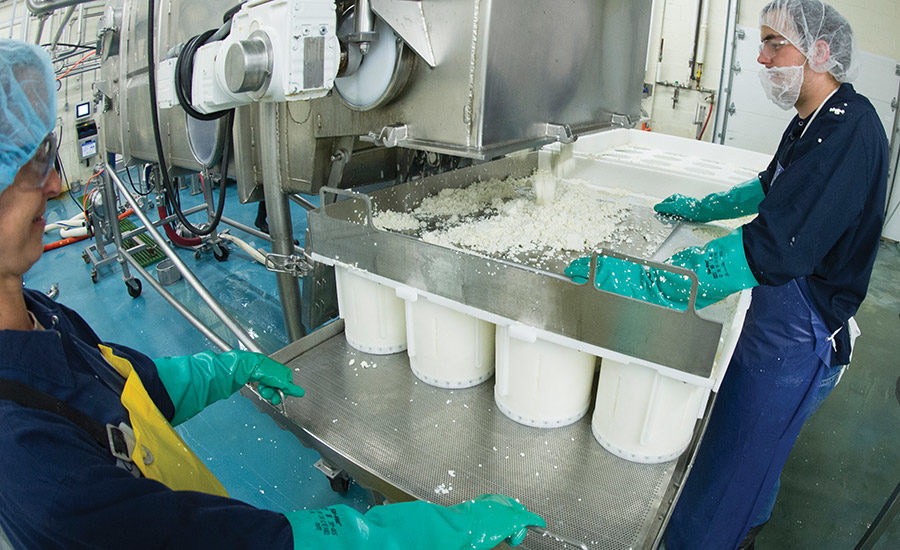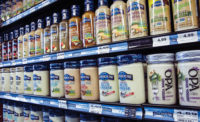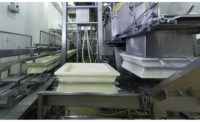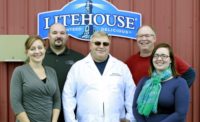Ed Hawkins invented a blue cheese buttermilk salad dressing that he served in his steakhouse. When customers asked if they could buy a bottle to take home, he knew it was a hit. Ed’s sons started a business to make and bottle the dressing. Later, they decided they also needed to make the blue cheese itself, rather than buying it from a supplier.
That, in a nutshell, is the story of Litehouse Inc., an award-winning maker of blue-veined cheeses and a leader in the refrigerated salad dressings category. Based in Sandpoint, Idaho, where it has three manufacturing facilities, Litehouse also has plants in Hurricane, Utah, and Lowell, Mich.
The Michigan and Utah plants manufacture salad dressings, vegetable and fruit dips, marinades, salsas and sauces. Litehouse also sells dried and freeze-dried herbs which are co-packed and imported from Germany. Litehouse acquired the Michigan plant when it merged with Chadalee Farms in 1997.
With sales growing steadily, Litehouse maxed out its manufacturing capabilities in Idaho. In 2011, it acquired a building in Hurricane, Utah, and built a manufacturing facility there. Litehouse selected the location in Utah for its access to major transportation routes, especially to California and Arizona, which are key markets, said Dan Hoffman, the company’s senior vice president of operations.
President and CEO Jim Frank said another reason the company selected Hurricane is “we’re kind of hooked on small communities and people.” (Sandpoint has a population of about 7,500.)
A well-traveled cheese
Dairy Foods visited Litehouse’s three production facilities in Idaho. The blue cheese is well-traveled before it ever hits store shelves. Cheese is made in one factory on Second Street in downtown Sandpoint. It is trucked to a cut-and-wrap and grinding facility in an industrial park across town. Then it is trucked to the salad dressing plant elsewhere in Sandpoint to be combined with buttermilk or yogurt, and bottled.
Dairy & Cheese Operations Manager Jay Peters and Quality Assurance Technical Manager Elizabeth Hawkins-Williams led Dairy Foods on a tour of the cheese factory, which is located behind a retail storefront. Litehouse receives a tanker of Holstein milk daily from southern Idaho. It takes about an hour to empty a tanker. It will be used for the next day’s cheesemaking. The company prefers Holstein milk because it is high fat and makes a creamy cheese, Peters explained.
While some plants can be highly automated, production here is mostly done by hand. Adding ingredients, cutting the curd, filling hoops, turning them and salting are all done by the seven plant employees.
After running through a HT/ST pasteurizer, the milk is pumped into four cheese vats that can hold 12,500 pounds of milk. Each vat will yield about 1,500 pounds of cheese. Cultures, rennet and salt are added and then mixed. After a couple of hours, the curd is cut, stirred and pumped to a de-wheying belt. Excess whey is collected and stored in a silo. It will be used to make buttermilk for the dressings.
Hoops are hand-filled with curd. About 10 pounds of curd will yield a wheel weighing 7.5 pounds after excess whey is drained off by gravity. The wheels are not pressed, Peters explained, because there needs to be pockets for the mold to grow.
The employees fill 800 to 1,100 hoops every day. The wheels sit overnight on 16 stainless steel tables and are flipped several times a day to develop an even shape and to promote mold growth. The cheese will remain in the plant for 24 hours. Although salt was added during the cheesemaking process, salt will be added by hand once more on the exterior of the wheels before leaving the factory. The wheels are hand-stacked on trays, wrapped in plastic and then put on a truck bound for the cut-and-wrap facility.
With all four cheese vats in use, the factory can make 6,000 pounds of cheese daily. Litehouse makes blue and gorgonzola cheeses four to five days a week. It takes about four hours to make one batch. The production is staggered throughout the day so that the vats are emptied at different times. Once a week, the plant makes a small batch of Cheddar curds. These much-anticipated squeaky cheese curds are sold in the retail shop and to employees.
Cheesemaker and Operations Manager Marvin Sharp was away during Dairy Foods’ visit. He is training his associates on the process and teaching them how to recognize when it is time to cut the curd. Besides this in-house training, Litehouse also sends employees to seminars at Washington State University.
Aging, cutting and wrapping
Cheese wheels are then sent to another facility in an industrial park about 10 minutes from downtown Sandpoint. Here, Litehouse ages the cheese, cuts and packages it for retail, and makes cultured dairy bases for salad dressings. Retail cheese will age for 100 days; the other products age for 90.
Employees punch holes in the cheese to help the blue molds bloom. They salt the wheels and dip them in an anti-fungal mixture because they don’t want mold on the rind, explained Buttermilk Plant Manager Lee Batrack. The wheels of cheese sit and develop color for 14 to 28 days in a curing room (held at a specific temperature range that promotes mold growth). Samples are cut to examine the color and the cheeses are graded. When the desired color has been achieved, cheeses are bagged and sent to an aging curing room (held at a refrigerated temperature to age another 85 days.) This is when the flavor is developed.
After the cheeses are aged, they are ready to be cut and packaged. Wheels are fed by hand into a grinder to create crumbles and smaller fines. The fines are used in a shake-from-the-jar product packaged in 4.5-ounce glass jars.
There are two other packaging lines that fill 4-ounce plastic cups with crumbles. The other line fills plastic pouches with the crumbles. A cutting station creates the eight-sided center-cut portions from wheels. A 5-ounce center-put portion is packaged in a lidded plastic cup.
Scales on all the lines ensure that the proper weights are achieved. All the packages pass through metal detectors. Employees rotate through different stations every 20 minutes to minimize fatigue from doing a repetitive task.
The buttermilk production facility is in the same industrial park as the cut-and-wrap operation. (Buttermilk was previously purchased from sources in Spokane, Wash.) Batrack directs the production, using whey captured as a by-product from the cheese plant. In a typical day, Litehouse makes two vats of buttermilk and one vat of Greek yogurt in the three 3,000-gallon vats, Batrack said.
Buttermilk production is a 24-hour process from start up to cool down. To make the buttermilk, Litehouse first makes skim milk by adding nonfat dry milk powder and stabilizers to water in the liquefier. Whey and skim milk are blended together and pasteurized. This helps to denature the proteins, achieves the desired viscosity and destroys any pathogens that may be in the buttermilk, Batrack said. Then the cultures are added and the mixture is heated and stirred. The buttermilk is held for four hours.
Dressing factory
The dressing factory, known as the Ella facility (because it is on Ella Avenue) is the largest of the three Sandpoint facilities. This is where Litehouse combines cheese and buttermilk to make dairy-based salad dressings. The plant also manufactures oil-based dressings and fruit dips.
The Ella plant has four mixing platforms with blenders and processing vats. Blue cheese is added to buttermilk along with house-made mayonnaise and other ingredients to make the blue cheese dressing. The mixture is pumped from the mixing station to the filler. Bottles are filled then capped and sealed with a neck band.
Litehouse makes various dressing formats, including 11- and 13-ounce jars, 20-ounce squeezable bottles, 32-ounce bottles for foodservice and club store accounts and gallons for institutional customers. There are also plastic pouches (called pillows) formed from roll stock and small dipping cups. These are used in salad kits sold by third parties.
The company describes its blue cheese prices as “mid-range.” Litehouse keeps its prices low because it makes its own cheese and yogurt, and it operates its own transportation network. That gives the company “some realcost advantages,” Frank said.
Litehouse can back up its claim of high quality by pointing to its SQF Level 3 certification for its dairy facilities. The company applied for Level 3, skipping over Level 2, because it felt it already had high-quality systems and documentation in place. Litehouse had to invest in some plant upgrades.
“It wasn’t as hard as you may think, because we had a lot of certifications in our plants already,” Frank said. “Our documentation base is really solid so we found that we would always pass desk audits for high-level certification. It took some work, but it was well within our grasp.”
Quality in manufacturing, products
SQF Level 3 gives customers “a higher level of confidence,” said Hoffman. And it plays into the company’s growth plans by giving retail customers assurance that Litehouse is a quality-minded manufacturer.
Litehouse’s cheese-making peers have honored the company with awards this year and last. In the 2016 American Cheese Society contest, Litehouse won first place for its Simply Artisan Reserve Double Crème Gorgonzola, second place for its Simply Artisan Reserve True Gorgonzola and third place for its Simply Artisan Reserve True Blue. Last year, Litehouse took first place for its Simply Artisan Reserve Blue Cheese.
Ed Hawkins had a good idea nearly 60 years ago. Today, the employee-owners of Litehouse have expanded his vision by developing and manufacturing salad dressings, cheeses and dips.
At-A-Glance
- Products made: blue-veined and gorgonzola cheeses; Greek yogurt dips; dairy- and oil-based refrigerated salad dressings and marinades
- Formats: Crumbles and center cuts in plastic cups, crumbles in pouches, sprinkles in glass jars, and full wheels in plastic wrap; spoonable and pourable refrigerated dressings in glass bottles
- Cheese vats: Four, each with a capacity of 1,500 gallons
- Pasteurization: HT/ST
- Buttermilk production: Three 3,000-gallon vats; liquefier










